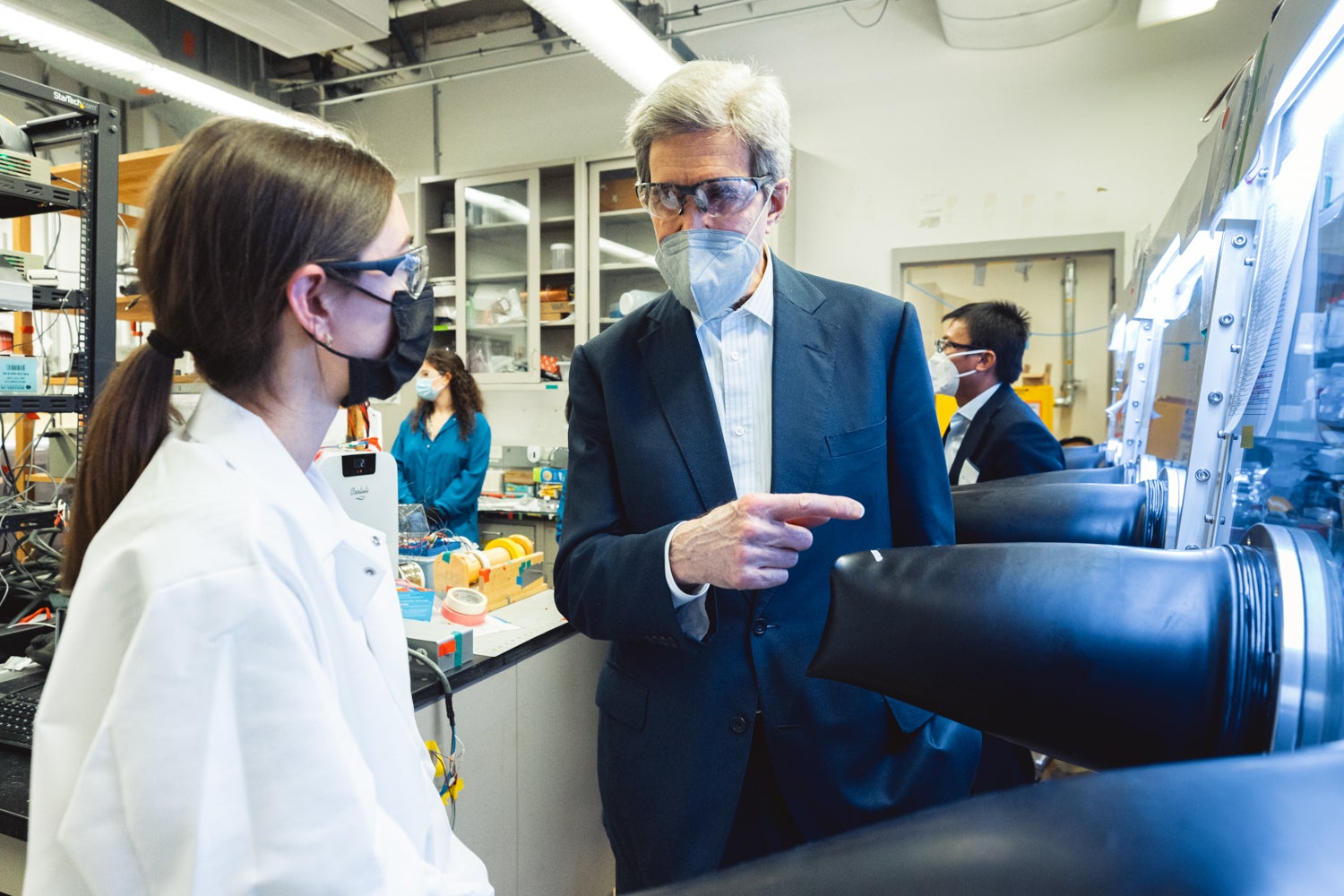During a trip to the Bay Area focused on climate technologies, U.S. Special Presidential Envoy for Climate John Kerry visited Stanford March 8 to learn more about the new school focused on climate and sustainability. He met with Stanford faculty and others involved in shaping the new school, saw presentations by Stanford alumni building innovative climate tech companies and toured labs that are developing breakthrough solutions.

John Kerry, U.S. special presidential envoy for climate, visited Stanford to meet with faculty and others involved in shaping the new school for climate and sustainability, and toured labs that are developing breakthrough solutions. (Image credit: Andrew Brodhead)
“Stanford has long been a global leader in developing the innovative technologies that change our world,” Kerry said. “Their new school focused on climate and sustainability, forward-thinking labs and faculty, and the climate startups developed by alumni make it clear that Stanford will continue to build the foundation for the innovative climate technologies critical to solving our most pressing challenges.”
When it launches in September 2022, the new school will bring together and expand on existing Stanford organizations, including the internationally recognized School of Earth, Energy and Environmental Sciences (Stanford Earth), Stanford Woods Institute for the Environment and Precourt Institute for Energy. The Department of Civil and Environmental Engineering will also join the new school as a joint department with the School of Engineering. The new school will include the facilities of Hopkins Marine Station, which had been administered by the School of Humanities and Sciences.
Joining these existing units are faculty from across the university and an anticipated 60 new faculty hires over the next 10 years. Recently launched cluster hires focus on climate science, sustainable development and environmental justice. The school will also include a Sustainability Accelerator to drive policy and technology solutions to urgent challenges.
“Secretary Kerry is a leader in our national conversation about climate change, and I’m delighted that he is visiting our campus to share his insights with Stanford students and faculty,” said Stanford President Marc Tessier-Lavigne. “I’m also pleased that we have this opportunity to share our plans with him for Stanford’s new school focused on climate and sustainability, which aims to deepen our insights about our planet, create new policy and technology solutions and train a new generation of leaders in sustainability.”

John Kerry (center left) and Yi Cui (center right), director of the Precourt Institute for Energy, touring Cui’s lab where he develops novel batteries and other green energy solutions. (Image credit: Andrew Brodhead)
During his tour Kerry visited SLAC National Accelerator Laboratory, which is one of 17 national labs overseen by the Department of Energy. SLAC facilities and scientists are a critical part of Stanford’s success in developing new technologies like improved batteries or solar panels.
Yi Cui, director of the Precourt Institute for Energy, has collaborated with SLAC scientists and made use of their facilities in his work developing novel batteries and other green energy solutions.
“We are incredibly lucky to have SLAC so close,” Cui said. “It’s an important part of why Stanford and the Precourt Institute have been so successful in developing new energy technologies, along with our proximity to Silicon Valley with its access to entrepreneurs and venture capitalists.”
Pressing climate questions
After a tour of Cui’s lab and presentations on green energy startups founded by alumni, Kerry took questions from undergraduate and graduate students in a chat moderated by Kathryn “Kam” Moler, transition dean of the new school.
Stuart Ferris, a geophysics PhD student, asked how energy companies could be motivated to accelerate the transition. Patrick Kim, an undergraduate math student, asked Kerry’s opinion on how conflicts between nation-states might alter or slow the transition. And postdoctoral fellow Pedro Monarrez asked about funding for the U.N. Green Climate Fund.
In his responses, Kerry focused on actions currently being taken by the U.S. and other countries, and the need for international agreement to make progress toward common goals. He referenced the success of the recent COP26 meeting in Glasgow, where he helped negotiate a deal in which close to 200 countries agreed to keep working toward limiting temperature rise to 1.5 C above pre-industrial levels.
Kerry also emphasized the urgency of acting soon.
“The future is going to be defined by these next years,” he said. “Particularly these next 10 years. You’ve all heard about net zero 2050. If we don’t do enough between 2020 and 2030 we won’t get to net zero by 2050.”
The goal of producing net zero greenhouse gas emissions by 2050 is one that has been embraced by an increasing number of governments, including the United States, as a way of avoiding going beyond 1.5 C of warming. Net zero is a calculation that includes both reducing emissions and also capturing and storing carbon.
Kerry returned to the issue of urgency in closing when Moler asked how students can make a difference. “Don’t be in a hurry to do something that you think is safe, because you are young enough to have time to make a lot of mistakes and go out there and take some risks. That’s what it takes to get this done,” he said. “Particularly with a Stanford education, you have the opportunity to make an enormous difference in this transition.”
Media Contacts
Amy Adams, University Communications: (650) 497-5908, amyadams@stanford.edu
Author
Amy Adams